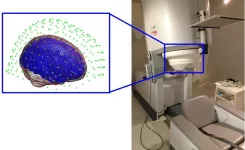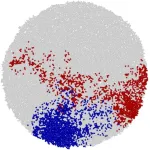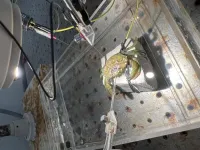(Press-News.org) CHICAGO – A new study of high school football players found that concussions affect an often-overlooked but important brain signal. The findings are being presented next week at the annual meeting of the Radiological Society of North America (RSNA).
Reports have emerged in recent years warning about the potential harms of youth contact sports on developing brains. Contact sports, including high school football, carry a risk of concussion. Symptoms of concussion commonly include cognitive disturbances, such as difficulty with balancing, memory or concentration.
Many concussion studies focus on periodic brain signals. These signals appear in rhythmic patterns and contribute to brain functions such as attention, movement or sensory processing. Not much is known about how concussions affect other aspects of brain function, specifically, brain signals that are not rhythmic.
“Most previous neuroscience research has focused on rhythmic brain signaling, which is also called periodic neurophysiology,” said study lead author Kevin C. Yu, B.S., a neuroscience student at Wake Forest University School of Medicine in Winston-Salem, North Carolina. “On the other hand, aperiodic neurophysiology refers to brain signals that are not rhythmic.”
Aperiodic activity is typically treated as ‘background noise’ on brain scans, but recent studies have shown that this background noise may play a key role in how the brain functions.
“While it’s often overlooked, aperiodic activity is important because it reflects brain cortical excitability,” said study senior author Christopher T. Whitlow, M.D., Ph.D., M.H.A., Meschan Distinguished Professor and Enterprise Chair of Radiology at Wake Forest University School of Medicine.
Cortical excitability is a vital part of brain function. It reflects how nerve cells, or neurons, in the brain’s cortex respond to stimulation and plays a key role in cognitive functions like learning and memory, information processing, decision making, motor control, wakefulness and sleep.
To gain a better understanding of brain rhythms and trauma, the researchers sought to identify the impacts of concussions on aperiodic activity.
Pre- and post-season resting-state magnetoencephalography (MEG) data was collected from 91 high school football players, of whom 10 were diagnosed with a concussion. MEG is a neuroimaging technique that measures the magnetic fields that the brain’s electrical currents produce.
A clinical evaluation tool for concussions called the Post-Concussive Symptom Inventory was correlated with pre- and post-season physical, cognitive and behavioral symptoms.
High school football players who sustained concussions displayed slowed aperiodic activity. Aperiodic slowing was strongly associated with worse post-concussion cognitive symptoms and test scores.
Slowed aperiodic activity was present in areas of the brain that contain chemicals linked with concussion symptoms like impaired concentration and memory.
“This study is important because it provides insight into both the mechanisms and the clinical implications of concussion in the maturing adolescent brain,” said co-lead author Alex I. Wiesman, Ph.D., assistant professor at Simon Fraser University in Burnaby, British Columbia, Canada. “Reduced excitability is conceptually a very different brain activity change than altered rhythms and means that a clear next step for this work is to see whether these changes are related to effects of concussion on the brain’s chemistry.”
The results highlight the importance of protective measures in contact sports. The researchers cautioned that young players should always take the necessary time to fully recover from a concussion before returning to any sport.
The findings from the study may also influence tracking of post-concussion symptoms and aid in finding new treatments to improve recovery.
“Our study opens the door to new ways of understanding and diagnosing concussions, using this novel type of brain activity that is associated with concussion symptoms,” Dr. Whitlow said. “It highlights the importance of monitoring kids carefully after any head injury and taking concussions seriously.”
Other co-authors are Elizabeth M. Davenport, Ph.D., Laura A. Flashman, Ph.D., Jillian Urban, Ph.D., Srikantam S. Nagarajan, Ph.D., Kiran Solingapuram Sai, Ph.D., Joel Stitzel, Ph.D., and Joseph A. Maldjian, M.D.
This work was supported by the National Institutes of Health (NIH) grants R01NS082453 and R01NS091602, NIH grant F32-NS119375, a Canadian Institutes of Health Research (CIHR) Banting Postdoctoral Fellowship (BPF-186555), and a CIHR Canada Research Chair (CRC-2023-00300).
###
Note: Copies of RSNA 2024 news releases and electronic images will be available online at RSNA.org/press24.
RSNA is an association of radiologists, radiation oncologists, medical physicists and related scientists promoting excellence in patient care and health care delivery through education, research and technologic innovation. The Society is based in Oak Brook, Illinois. (RSNA.org)
For patient-friendly information on brain imaging, visit RadiologyInfo.org.
END
Laboratory experiments with cancer cells reveal two ways in which tumors evade drugs designed to starve and kill them, a new study shows.
While chemotherapies successfully treat cancers and extend patients’ lives, they are known not to work for everyone for long, as cancer cells rewire the process by which they convert fuel into energy (metabolism) to outmaneuver the drugs’ effects. Many of these drugs are so-called antimetabolics, disrupting cell processes needed for tumor growth and survival.
Three such drugs used in the study — raltitrexed, N-(phosphonacetyl)-l-aspartate (PALA), and brequinar ...
Climate change is the single biggest threat to the global environment and socio-economic development – demanding an urgent transformation of the United Nations’ Sustainable Development Goals (SDGs), according to a new study.
The UN SDGs were created to end poverty, build social-economic-health protection and enhance education and job opportunities, while tackling climate change and providing environmental protection.
Following last week’s COP29 environmental summit in Baku, University of Birmingham experts say that, as climate action is linked to sustainable development, systematic integration of climate resilience into every ...
UNDER STRICT EMBARGO UNTIL 10.00AM (UK TIME) ON 26 NOVEMBER 2024
New study reveals genetic drivers of early onset type 2 diabetes in South Asians
Peer reviewed | Observational study | People
A genetic predisposition to having lower insulin production and less healthy fat distribution are major causes of early-onset type 2 diabetes in British Asian people. According to new research from Queen Mary University of London, these genetic factors also lead to quicker development of health complications, earlier need for insulin treatment, and a weaker response ...
RICHLAND, Wash. —Tip the first tile in a line of dominoes and you’ll set off a chain reaction, one tile falling after another. Cross a tipping point in the climate system and, similarly, you might spark a cascading set of consequences like hastened warming, rising sea levels and increasingly extreme weather.
It turns out there’s more to weigh than catastrophic environmental change as tipping points draw near, though. Another point to consider, a new study reveals, is the cost of undoing the damage.
The cost of reversing the effects of climate change—restoring melted polar sea ice, for ...
While Jupiter's Great Red Spot has been a constant feature of the planet for centuries, University of California, Berkeley, astronomers have discovered equally large spots at the planet's north and south poles that appear and disappear seemingly at random.
The Earth-size ovals, which are visible only at ultraviolet wavelengths, are embedded in layers of stratospheric haze that cap the planet's poles. The dark ovals, when seen, are almost always located just below the bright auroral zones at each ...
Researchers at the University of Cologne and the Centre for Genomic Regulation (CRG) in Barcelona have discovered that cancer grows uniformly throughout its mass, rather than at the outer edges. The work, published today in the journal eLIFE, challenges decades-old assumptions about how the disease grows and spreads.
“We challenge the idea that a tumour is a ‘two-speed’ entity with rapidly dividing cells on the surface and slower activity in the core. Instead, we show they are uniformly growing masses, where every region is equally active and has the potential ...
The Arctic is warming two to four times faster than the global average. A recent study by researchers in Japan found that dust from snow- and ice-free areas of the Arctic may be an important contributor to climate change in the region. The findings were published in the journal npj Climate and Atmospheric Science.
According to one view, higher temperatures in the Arctic are thought to lead to the region's clouds containing more liquid droplets and fewer ice crystals. Clouds become thicker, longer lasting, ...
Researchers from the University of Gothenburg are the first to prove that painful stimuli are sent to the brain of shore crabs providing more evidence for pain in crustaceans. EEG style measurements show clear neural reactions in the crustacean's brain during mechanical or chemical stimulation.
In the search for a better welfare of animals that we humans kill for food, researchers at the University of Gothenburg have chosen to focus on decapod crustaceans. This includes shellfish delicacies such as prawns, lobsters, crabs and crayfish that we both catch wild and farm. Currently, ...
Social stress is bad for your brain. It’s a prime suspect in the accumulation of oxidative stress in the brain, which is believed to contribute to mental health and neurodegenerative disorders — but the mechanisms that turn social stress into oxidative stress, and how social status affects this, are poorly understood. By studying a highly social, very hierarchical fish species, cichlids, scientists have now found that social stress raises oxidative stress in the brains of low-status fish.
“We found that low rank was generally linked to higher levels of oxidative stress in the brain,” said Dr Peter Dijkstra of ...
Due to the growing reality of global warming and climate change, there is increasing uncertainty around meteorological conditions used in energy assessments of buildings. Existing methods for generating meteorological data do not adequately handle the interdependence of meteorological elements, such as solar radiation, air temperature, and absolute humidity, which are important for calculating energy usage and efficiency.
To address this challenge, a research team at Osaka Metropolitan University’s Graduate School of Human Life and Ecology—comprising Associate ...






